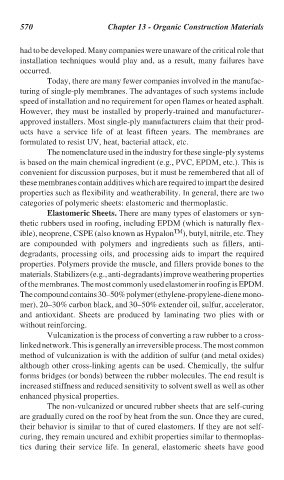Page 603 - Handbook of Thermal Analysis of Construction Materials
P. 603
570 Chapter 13 - Organic Construction Materials
had to be developed. Many companies were unaware of the critical role that
installation techniques would play and, as a result, many failures have
occurred.
Today, there are many fewer companies involved in the manufac-
turing of single-ply membranes. The advantages of such systems include
speed of installation and no requirement for open flames or heated asphalt.
However, they must be installed by properly-trained and manufacturer-
approved installers. Most single-ply manufacturers claim that their prod-
ucts have a service life of at least fifteen years. The membranes are
formulated to resist UV, heat, bacterial attack, etc.
The nomenclature used in the industry for these single-ply systems
is based on the main chemical ingredient (e.g., PVC, EPDM, etc.). This is
convenient for discussion purposes, but it must be remembered that all of
these membranes contain additives which are required to impart the desired
properties such as flexibility and weatherability. In general, there are two
categories of polymeric sheets: elastomeric and thermoplastic.
Elastomeric Sheets. There are many types of elastomers or syn-
thetic rubbers used in roofing, including EPDM (which is naturally flex-
ible), neoprene, CSPE (also known as Hypalon TM ), butyl, nitrile, etc. They
are compounded with polymers and ingredients such as fillers, anti-
degradants, processing oils, and processing aids to impart the required
properties. Polymers provide the muscle, and fillers provide bones to the
materials. Stabilizers (e.g., anti-degradants) improve weathering properties
of the membranes. The most commonly used elastomer in roofing is EPDM.
The compound contains 30–50% polymer (ethylene-propylene-diene mono-
mer), 20–30% carbon black, and 30–50% extender oil, sulfur, accelerator,
and antioxidant. Sheets are produced by laminating two plies with or
without reinforcing.
Vulcanization is the process of converting a raw rubber to a cross-
linked network. This is generally an irreversible process. The most common
method of vulcanization is with the addition of sulfur (and metal oxides)
although other cross-linking agents can be used. Chemically, the sulfur
forms bridges (or bonds) between the rubber molecules. The end result is
increased stiffness and reduced sensitivity to solvent swell as well as other
enhanced physical properties.
The non-vulcanized or uncured rubber sheets that are self-curing
are gradually cured on the roof by heat from the sun. Once they are cured,
their behavior is similar to that of cured elastomers. If they are not self-
curing, they remain uncured and exhibit properties similar to thermoplas-
tics during their service life. In general, elastomeric sheets have good

